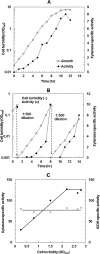Multiple regulatory mechanisms control the expression of the Geobacillus stearothermophilus gene for extracellular xylanase
- PMID: 25070894
- PMCID: PMC4162194
- DOI: 10.1074/jbc.M114.592873
Multiple regulatory mechanisms control the expression of the Geobacillus stearothermophilus gene for extracellular xylanase
Abstract
Geobacillus stearothermophilus T-6 produces a single extracellular xylanase (Xyn10A) capable of producing short, decorated xylo-oligosaccharides from the naturally branched polysaccharide, xylan. Gel retardation assays indicated that the master negative regulator, XylR, binds specifically to xylR operators in the promoters of xylose and xylan-utilization genes. This binding is efficiently prevented in vitro by xylose, the most likely molecular inducer. Expression of the extracellular xylanase is repressed in medium containing either glucose or casamino acids, suggesting that carbon catabolite repression plays a role in regulating xynA. The global transcriptional regulator CodY was shown to bind specifically to the xynA promoter region in vitro, suggesting that CodY is a repressor of xynA. The xynA gene is located next to an uncharacterized gene, xynX, that has similarity to the NIF3 (Ngg1p interacting factor 3)-like protein family. XynX binds specifically to a 72-bp fragment in the promoter region of xynA, and the expression of xynA in a xynX null mutant appeared to be higher, indicating that XynX regulates xynA. The specific activity of the extracellular xylanase increases over 50-fold during early exponential growth, suggesting cell density regulation (quorum sensing). Addition of conditioned medium to fresh and low cell density cultures resulted in high expression of xynA, indicating that a diffusible extracellular xynA density factor is present in the medium. The xynA density factor is heat-stable, sensitive to proteases, and was partially purified using reverse phase liquid chromatography. Taken together, these results suggest that xynA is regulated by quorum-sensing at low cell densities.
Keywords: Gene Regulation; Glycoside Hydrolase; Gram-positive Bacteria; Nif3-like Family; Plant Cell Wall; Quorum Sensing; Thermophile; Transcription Repressor; Transformation; Xylanase.
© 2014 by The American Society for Biochemistry and Molecular Biology, Inc.
Figures














References
-
- Shallom D., Shoham Y. (2003) Microbial hemicellulases. Curr. Opin. Microbiol. 6, 219–228 - PubMed
-
- Yu H., Zeng G., Huang H., Xi X., Wang R., Huang D., Huang G., Li J. (2007) Microbial community succession and lignocellulose degradation during agricultural waste composting. Biodegradation 18, 793–802 - PubMed
-
- Ouyang J., Yan M., Kong D., Xu L. (2006) A complete protein pattern of cellulase and hemicellulase genes in the filamentous fungus Trichoderma reesei. Biotechnol. J. 1, 1266–1274 - PubMed
-
- Gilbert H. J., Stålbrand H., Brumer H. (2008) How the walls come crumbling down: recent structural biochemistry of plant polysaccharide degradation. Curr. Opin. Plant Biol. 11, 338–348 - PubMed
Publication types
MeSH terms
Substances
Associated data
- Actions
- Actions
LinkOut - more resources
Full Text Sources
Other Literature Sources

